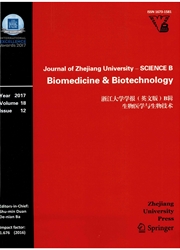

 中文摘要:
中文摘要:
目的:研究真菌固态发酵对丹参抗氧化活性的影响及探索丹酚酸富集的途径。创新点:该研究发现真菌G.luteus固态发酵可增加丹参的抗氧化活性及有效地富集丹酚酸B,为丹参更有效的开发利用提供了新思路。方法:采用20种真菌对丹参进行固态发酵,以两种抗氧化模型(二苯代苦味酰基自由基(DPPH·)和2,2'-联氮基双(3-乙基苯并噻唑啉-6-磺酸)二铵盐自由基(ABTS^+·))测定发酵物的抗氧化活性;采用Folin-Ciocaltea比色法测定发酵物的总酚含量;以多种波谱学方法(紫外光谱(UV)、红外光谱(IR)和核磁共振波谱(NMR))和高效液相色谱法(HPLC)表征发酵前后丹参化学成分的变化。结论:抗氧化活性测试和总酚测定结果表明,G.luteus发酵可有效地增加丹参的抗氧化活性和总酚含量。UV、IR及NMR等波谱表征发现,在丹参经G.luteus发酵后,丹酚酸类化合物的含量提高了;同时HPLC测定也发现,丹酚酸B含量显著增加。这些结果表明,G.luteus发酵可实现丹酚酸B的富集。
 英文摘要:
英文摘要:
The antioxidant activities and total phenolic content of fermented Salvia miltiorrhiza with fungus Geomyces luteus were investigated. The results revealed that G. luteus fermentation could significantly improve the antioxidant activity and total phenolic content of S. miltiorrhiza. The main antioxidant constituents were characterized by spec- troscopic analysis as salvianolic acids. High-performance liquid chromatography (HPLC) quantification also showed the enhanced content of salvianolic acid B after fermentation. The present study suggests that G. luteus fermentations are effective in the S. miltiorrhiza salvianolic acids' enrichment process.
 同期刊论文项目
同期刊论文项目
 同项目期刊论文
同项目期刊论文
 期刊信息
期刊信息
